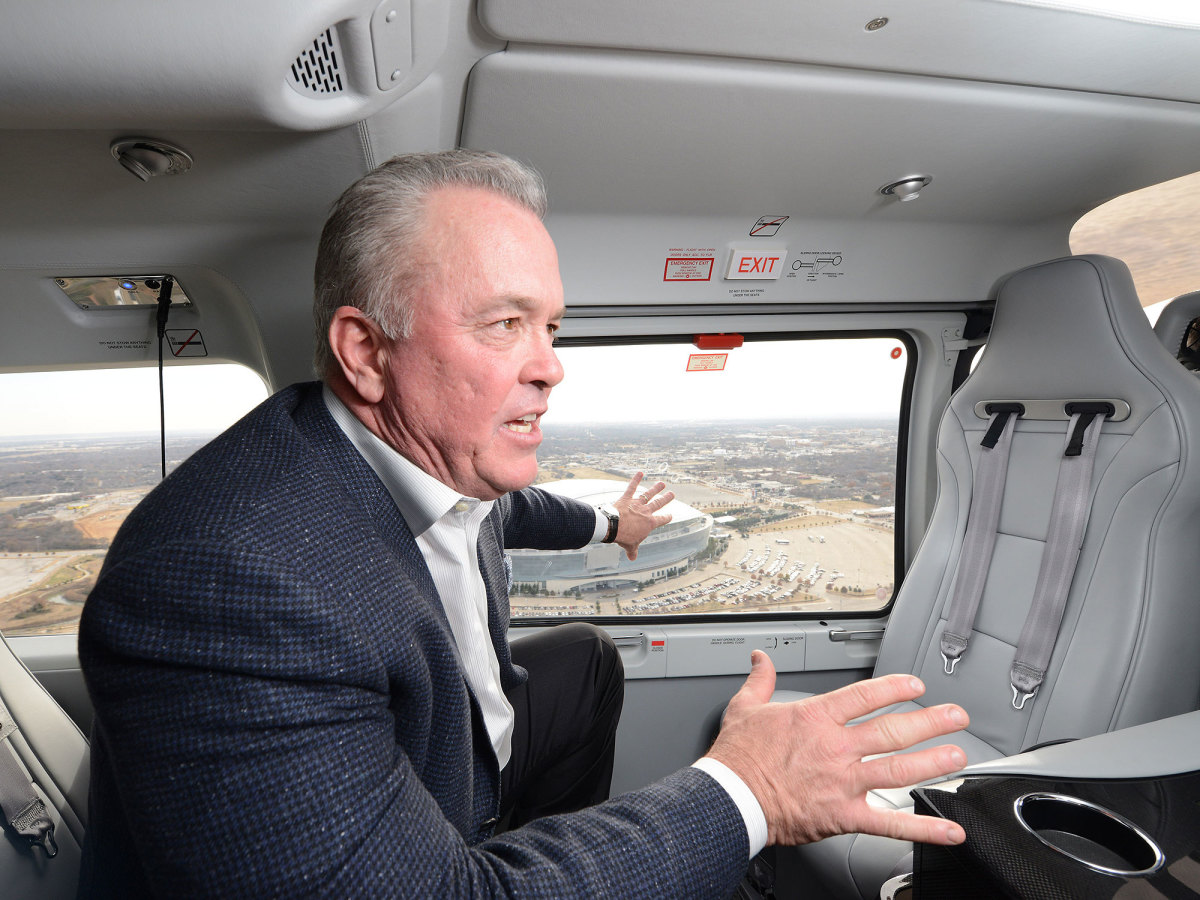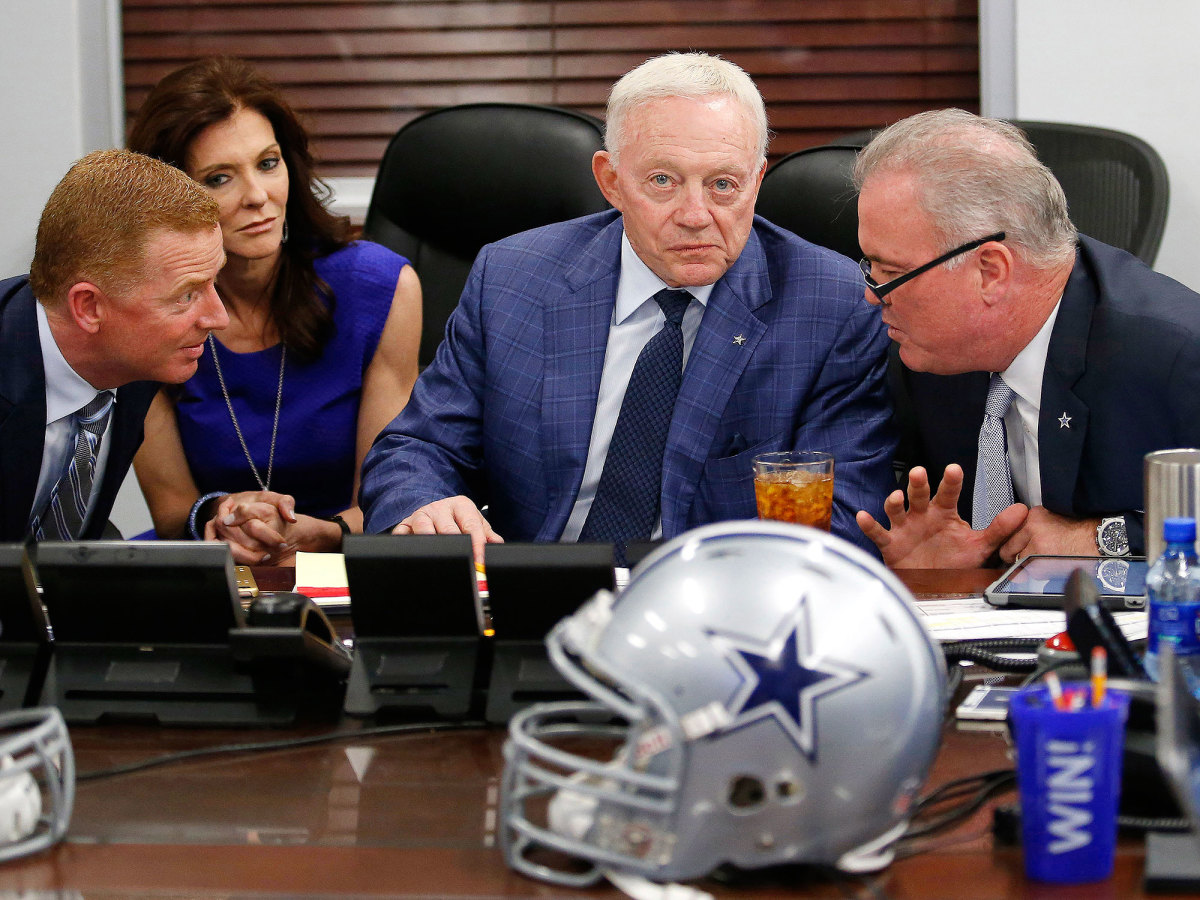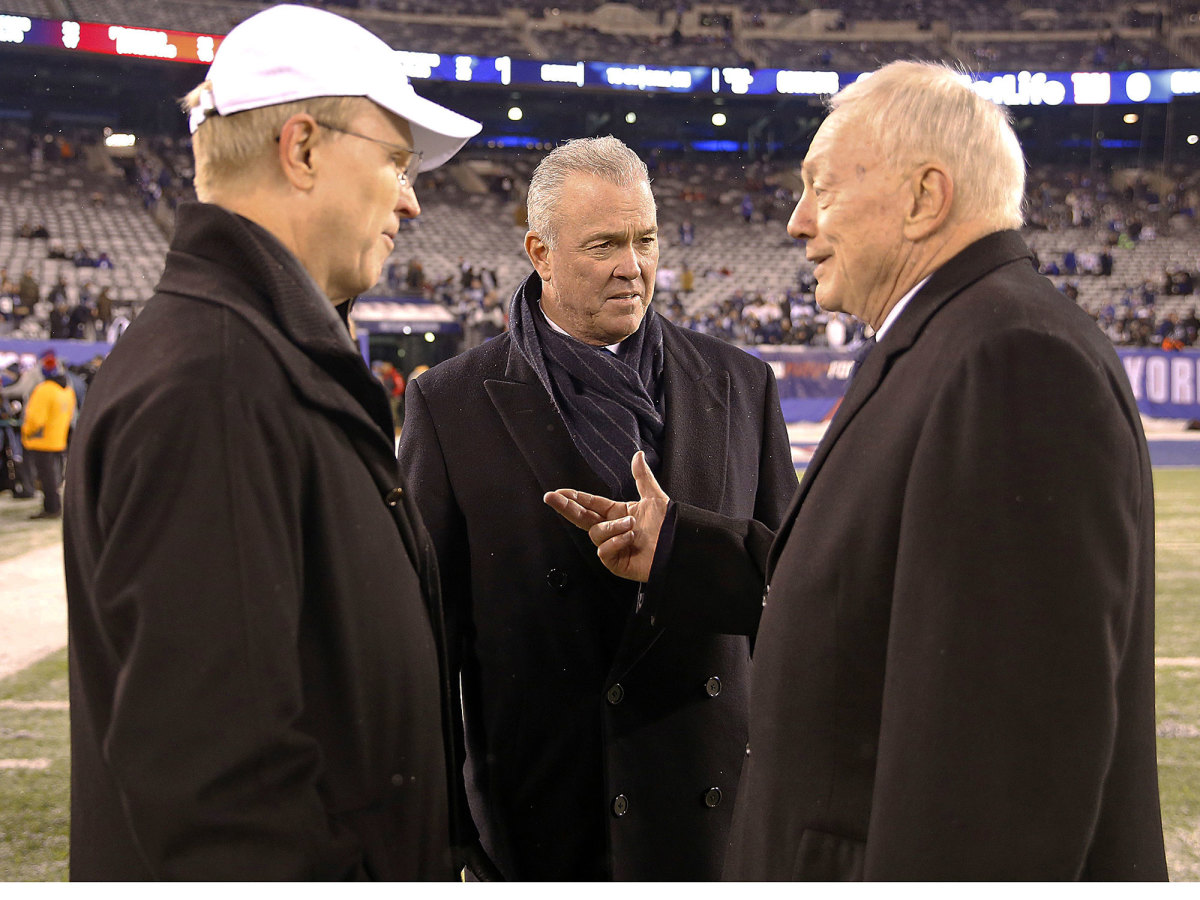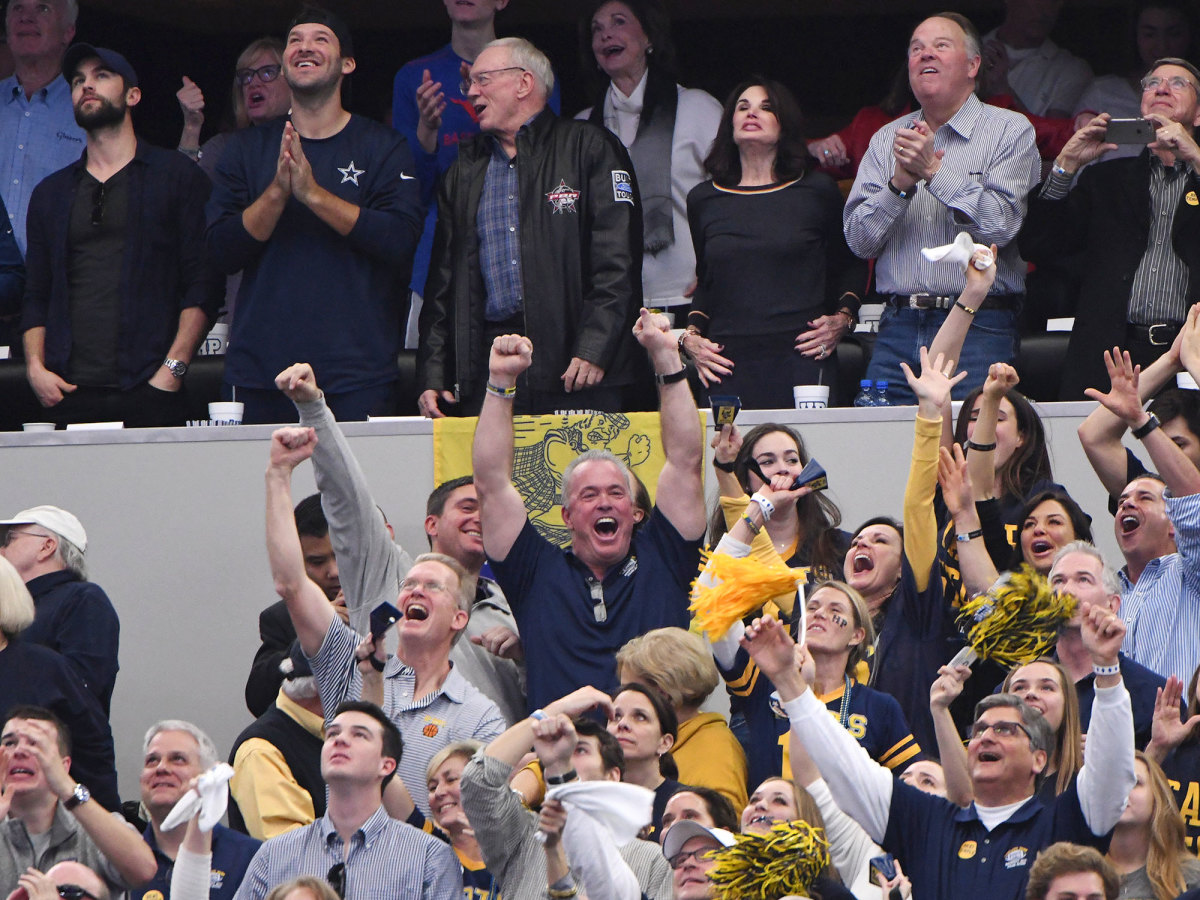A Breath of Fresh Heir: Stephen Jones following in the shadow cast by his father

Stephen Jones already wears three hats for the Cowboys, but on a cloudy December afternoon the team’s CEO, director of player personnel and executive vice president has added a fourth: helicopter tour guide.
With the grand opening in August of the Star, the club’s gleaming, 91-acre, multipurpose headquarters in Frisco, 25 miles north of downtown Dallas, it made sense for Jerry Jones, the Cowboys’ owner (and Stephen’s father), to invest in a new toy: a nine-seat H145 Airbus helicopter. Some days, when traffic is dense and time is of the essence—and, let’s be honest, some days when it isn’t—the Joneses opt for the chopper.
“Our stadium is halfway between Dallas and Love Field,” says Stephen, 52, raising his voice above the rotors as the Cowboys’ heir takes to the air, headed west toward AT&T Stadium, aka Jerry World, aka the Jones Mahal. The plan is to take a few laps around that eight-year-old state-of-the-art structure, then head to the Star, which is, if anything, state-of-the-artier. But first, a blast from the past. As his ride climbs to 1,500 feet, the Dallas skyline looming to the south, Jones points below toward a large, vacant lot ringed by construction cranes. “That’s where the old stadium sat.”
He is referring here to the razed Texas Stadium, renowned for the hole in its roof, left open so God could watch His favorite team play—or so went the old Cowboys quip. By 2006, with the Jones Mahal under construction in Arlington, that quasi-dome was doomed, deemed insufficiently grand for such a storied franchise.
Blanket Coverage: Lessons new coaches can take from the Belichick Blueprint
Dingy though it was in the end, Texas Stadium held a place in the heart of many a Cowboys fan. It was, after all, the team’s home for four of its five Super Bowl-winning seasons, the most recent in 1995. In the intervening two decades Dallas has won exactly two playoff games. It is a testament, then, to the marketing genius of Jones père that the value of his franchise—Forbes recently pegged it at $4 billion, No. 1 in the world—swelled even as the Cowboys endured an on-field drought of Biblical proportions.
The long wait for a sixth title could be nearing its end, if not this season then soon. In addition to their 13 wins and first-round bye, the 2016 Cowboys have that certain ineffable something that often attends championship teams. Just when it looked as if rookie QB Dak Prescott might be losing his luster, with pundits pounding the drums for a late-season change to Tony Romo, the 23-year-old muted critics with a 32-for-36, zero-pick masterpiece in a 26–20 Week 15 win over the playoff-hopeful Buccaneers.
“Dak took a lot of the air out of that controversy,” notes Jones, winging west over I-30. “He didn’t just play good, he played great.”
Jones’s expression turns serious as he talks about how tough it’s been for Romo to watch this special season from the sideline. “God bless him, he’s made it easy [for Prescott and his teammates],” Stephen says, “especially when you consider how fired up he was to get to work with the team we’ve put together.”
These days, a popular parlor game is speculating on possible Romo landing spots. “I’m sure a lot of people would love to have him,” says Jones. “The big thing with Tony is, Can he stay healthy? He’s had a hell of a time doing that.”

Fretting about the feelings of the QB supplanted by one of the most gifted newcomers in NFL history—this is not a bad problem to have. After years of mostly mediocre coaches, following a raft of awful draft picks, this season’s Cowboys have poured a foundation for sustained success, the structural soundness of which will be tested on Sunday in the NFC divisional round when they host the Packers. Having conjured what coach Jason Garrett calls “a vision of what you want your team to look like” and the style it should play—in this case, a knockoff of those dynastic 1990s Cowboys, with a trio of transcendent skill players sprung by a sensational O-line—the Dallas brain trust has displayed the acumen to evaluate which players will fit that blueprint and the discipline to get them.
One of the people most responsible for guiding the team into this promising territory is the enthusiastic guide on this helicopter journey. “See the big shell out there?” says Stephen Jones. “That’s AT&T Stadium. And those tall buildings in the background—that’s Fort Worth.”
He points out the Miller Lite Corral, where fans gather before entering Jerry World, and the nearby helipad used by the Joneses as well as a handful of fans in the same financial stratum. The vast AT&T logo on the venue’s roof is a tasteful platinum color, and therein lies a story: “We talked ’em into not making it their usual orange and blue,” Jones beams.
From the stadium’s east plaza, a giant silver sculpture reflects the sun and clouds back at the chopper. This is the Sky Mirror, by the British sculptor Anish Kapoor, a 35-foot-wide stainless steel disk, its concave face angled up like a satellite dish.
If that mirror could reflect the sources of this team’s success, it would linger on a 15-minute span in the Cowboys’ war room on May 8, 2014—the night of the NFL draft’s first round.

Johnny Manziel was supposed to have been picked by now—but there he was, fidgeting in the green room at Radio City Music Hall, when it came time for the Cowboys to use their selection at No. 16.
This was going to be a problem for Dallas. Jerry Jones was smitten with the Heisman-winning Texas A&M quarterback. But the men Jones had hired to help him make those decisions? Not so much. “If you’re scared [of Manziel],” one Cowboys executive joked to Stephen, one of those draftniks, “then I’m really scared.”
“I’ll never forget that morning,” recalls Stephen. “Jerry said, ‘Let’s go through the [prospects] again, make sure we all see eye to eye on how we’ve got ’em ranked.’” If Manziel was still there at 16, the patriarch added, “I assume we’d take him—wouldn’t we?”
• All Sixth-Round Team: Best lineup of players drafted in Round 6
Replied Stephen, with some delicacy, “Well, I don’t think we would.”
Jerry acquiesced: If any of three defensive players were still available—linebackers Ryan Shazier or Anthony Barr or tackle Aaron Donald—the Cowboys would choose one of them before the quarterback.
“And Zack,” Stephen reminded his father. Indeed, Dallas had Notre Dame guard Zack Martin higher on its board than Manziel. But Jerry wasn’t making any promises.
Surely it wouldn’t come to that, father and son finally agreed. Surely, by then, Manziel would be gone—or one of the defenders would still be available.
It came to that.
2017 NFL Mock Draft 4.0: Where the teams that missed the playoffs should turn
“So there we were, staring at Johnny and Zack Martin,” Stephen says. Jerry went around the table trying to wrangle support for Manziel, but he came up empty. “Lonely is the right word,” Jerry says. “I don’t think there was another soul in the room” who shared the owner’s enthusiasm for Johnny Football. Instead, Jerry suggested his team trade out of the pick. “But no one was calling to trade,” explains Stephen. By this time the boss “was not happy,” says the son. Exasperated, Jerry finally asked, “So no one in this room wants to take Johnny Manziel?”
“There wasn’t a peep,” says Stephen, who told his old man, “Dad, we need to take Zack.”
“All right,” came the reply. “Turn it in.”
Jerry turned to Stephen, having discerned in the drama a teaching moment. “Son, I hope you’re happy,” Jerry said. “But let me tell you something: You don’t get to own the Cowboys, you don’t get to do special things in life, by making major decisions going right down the middle. And that“—taking an offensive lineman over Johnny Football—“was right down the middle.”
Manziel, of course, went 22nd to the Browns and was out of football 22 months later. Martin became the first Cowboys rookie in 45 years to be named an All-Pro. Running behind him, and the other members of the NFL’s best O-line, DeMarco Murray led the league in rushing in 2014, just as Ezekiel Elliott did as a rookie this season, after which he too was named an All-Pro. Because the checks and balances the Cowboys have in place worked—barely, but they worked!—the team did not draft Manziel, which left Dallas free to take a quarterback in the fourth round two years later. That QB, Prescott, turned in the best statistical season by a first-year passer in NFL history.
Sometimes it’s not bad to play it right down the middle.
Divide and Conquer: The running backs behind the Falcons' push to the postseason
Father and son complement each other. While Stephen is comfortable in front of TV cameras, he is less inclined than his boss to seek them out. He’s charming, disarming, a good listener, a keen observer and (although the family is reluctant to discuss the matter) the odds-on favorite of the three Jones offspring to succeed Jerry when the time comes. While the old man, now 74, is known as the visionary—“Jerry sees around corners,” says former NFL general manager Bill Polian—Stephen is “the details guy, the one who negotiated with agents, crossed the t’s and dotted the i’s,” says Barry Switzer, who coached the Cowboys to that last Super Bowl win. Yes, father casts a shadow over son, “but Stephen casts his own long shadow,” says Switzer, who has long admired the younger Jones’s big brain. While lettering four years as a linebacker at Arkansas in the mid-1980s, Stephen majored in chemical engineering, a source of awe in NFL circles.
“So what if he’s a billionaire?” says Polian, who worked with Stephen for five years on the Competition Committee. “He doesn’t have any airs about him. He’s also exceptionally smart.”
And not just book smart. “Stephen has some substance now,” says Ravens GM Ozzie Newsome, another Competition Committee member. “And that substance, that knowledge of when to tap the brakes, when to hit the gas, has aided Jerry and the Cowboys in the decisions they’ve made over the last four or five years.”
Which could be Newsome’s polite way of saying what everyone’s been thinking lately: What’s going on?! The Cowboys haven’t screwed up a draft in recent memory!
Jerry may be able to see around corners, but for the longest time he struggled mightily to draft corners—or players at almost every other position, really. No más. Whatever process the club has settled on, it’s working. And by all accounts, Stephen has played a key role in that success. Yes, he’s a sound personnel man who devours video and brandishes strong opinions on potential signees. But he’s also a buffer and shuttle diplomat among scouts, coaches and personnel men, and their boss, his father, with whom he’s unafraid to butt heads.
“He knows how to handle his dad,” says Will McClay, Dallas’s assistant director of player personnel. “Even when they disagree, there’s always that respect, that reverence.”
Which brings us to the rasslin’ story.

Jim Counce, now a heart surgeon, was a starter on the 1977–78 Arkansas basketball team, which reached the Final Four. In ’80 he married Stephen Jones’s aunt Kathy, but because Kathy and Jim were so much younger than Stephen’s mother, Gene, Counce felt more like a cousin to Stephen than an uncle. Which (sort of) explains how uncle and nephew ended up wrestling at a family function in the late ’70s.
Counce was 6' 7" and five years older than Stephen. But Stephen was in good shape, getting ready for his freshman season at Arkansas. “I got him down,” Stephen recalls, “and put him in a hold he couldn’t get out of.”
Here, Jerry picks up the story: “He got Jim around the neck, and everybody in the room was worried he was going to squeeze Jim’s head off. Women were crying, everybody was hollering—but Stephen wasn’t going to let go.”
After separating the combatants, Jerry summoned his son for a private chat.
“I know, Dad,” Stephen said. “We took it too far.”
But Jerry was less angry than ... impressed. “I rassle you,” he said, “and you’ve never done that to me.”
Not missing a beat, Stephen responded, “There are some things you just don’t do to your dad.”
Broncos roll the dice hiring highly coveted but untested Vance Joseph
Decades later, TV producers working Cowboys games always keep a camera trained on the owner’s suite in the final seconds of victories. Invariably, Stephen and his father share a robust man-hug, a tender made-for-TV moment. You may be put off by Jerry’s propensity for self-promotion, or his Lone Star State-sized ego. But to spend a couple of days around Stephen is to come away convinced that Jerry Jones was, and is, a damn good father. Jerry’s father, J.W. (Pat) Jones, owned a grocery store—and later, a chain of them—in Arkansas. As a nine-year-old, the bow-tied Jerry would stand at the entrance, greeting customers. While far more colossal an enterprise, the Cowboys retain the same feel of a family business. Stephen’s sister, Charlotte, has been a driving force behind completing the Star on schedule; brother Jerry Jr. is the team’s chief sales and marketing officer.
Before he owned a team, Jerry was a wildcatter in the oil business, working patches in Oklahoma. When Stephen was nine and 10, Jerry would fly back to his home in Little Rock just to coach the boy’s youth football games, then head straight back to the airport. “I thought I was doing it for him,“ Jerry says now. “I later learned that the one who got the most out of it was me.”
Stephen comprehends this all on a cellular level. His office at the Star is adorned by images of three quarterbacks: poster-sized paintings of Troy Aikman and Romo, plus two 8-by-10 photographs of an intense-looking teen in a number 9 jersey. Five days earlier, in the opulent stadium he might inherit one day, John Stephen Jones—the fourth of Stephen and Karen’s four kids, whose two first names prevent people from confusing him with his father—scored both of Highland Park High’s TDs in a 16–7, 5A Division I state championship victory over Temple. Bear hugs and happy tears ensued.
“My job at these games,” says Jerry, who along with his son saw every snap of the Scots’ season, “has been to stand by in case Stephen needs emergency respiration.” After the win over Temple, he added this: “That is the happiest—the happiest—I have ever seen my son.”

Stephen, too, had been a standout prep quarterback, in Little Rock, good enough to be recruited by Princeton, where he would have competed for the QB job with a ginger-haired freshman named Jason Garrett. Instead Stephen chose Arkansas, and the world was cheated of the spectacle of Jerry Jones holding forth at Ivy League tailgate parties.
Right out of college, Stephen signed on with Jones Oil (or as he pronounces it, his dad’s “ol bidness”). In short order he found himself helping to sell that company to finance Jerry’s 1989 purchase of the Cowboys from H.R. (Bum) Bright for $151 million. Stephen’s MBA plans were put on hold. “I was so knee-deep in the Cowboys,” he says, “I never looked back.”
“We were in some pretty high grass,” says Jerry. The team was losing $1 million a month. “This was not a hobby. It was dead serious, and Stephen was right in the middle of it. I gave him a lot of responsibility.”
When coach Jimmy Johnson left the Cowboys following their Super Bowl XXVIII win in January 1994, “things were strained between [Jimmy and me],” says Jerry in a rare understatement. But while Johnson was openly critical of the father, he was always complimentary of the son. Later, Stephen learned from—and jousted with—another Super Bowl-winning coach after his father hired Bill Parcells in 2003.
Today’s Cowboys brass speak often of its “vision” of the team, of finding players to plug into that template. For Stephen, the seed of that philosophy was planted by Parcells, who early on insisted that the team drastically cut its draft board. “Half the players we’re putting up here are clutter,” the coach said. “If they don’t fit into our system or fit into a player profile that we like, they shouldn’t be on our board.”
During his four years in Dallas, Parcells asked that Stephen, who served as a kind of assistant GM, meet with him in the coach’s office every morning at eight. Some days, if Stephen was going to be in the building, connecting with coaches and watching tape, he’d wear a polo shirt. On others, when he was selling suites or sponsorships, he’d don a suit, complete with a pocket square. Parcells would see the suit and sigh.
“I’d walk into his office, and he’d go, ’Stadium Steve today.’” Pointing at the pocket square, Parcells would say, in an accusing tone, “See that hankie? That means you’re gonna be out there selling Dr. Pepper and Pepsi and Ford trucks today, working on things that aren’t important to Bill.” Then they’d both laugh.
After a few loops around AT&T Stadium, the pilot points the chopper north. Before reaching Frisco, Stephen motions toward an aircraft-carrier-sized structure hard by the Sam Rayburn Tollway. This, he explains, is the Nebraska Furniture Mart, next to which an IKEA store would look petite and streamlined—and yes, it is germane to our story. For the Furniture Mart resides in The Colony, a 16-square-mile city just south of Frisco, even though it was Frisco officials who first coveted and made a generous offer of land as a home for the megastore. Alas, Frisco was outbid by its neighbor.
No hard feelings. After losing that bid, says Jones, “[Frisco] used that property to do their deal with us.” The city kicked in $90 million toward a parking lot and 12,000-seat indoor stadium. (By the time the complex is complete this summer—with its hotel, restaurants, retail spaces and 200,000-square-foot sports medicine facility—the Joneses will have spent another $800 million.) In exchange, the district’s eight high schools will each play two home football games per season in that venue, on the Cowboys’ practice field. The schoolboys will share facilities, and occasionally small talk, with the pros. It’s a sublime, cutting-edge arrangement.
Circling the Star just before his pilot touches down, Stephen notes with pleasure several touch football games in progress on the miniature turf field by the facility’s entrance. “Jerry always says, You don’t really buy the Dallas Cowboys—you just own the right to run the team for a period of time,” he says. “You come in, and hopefully you leave ’em in a better place than where you found ’em.”
Stepping out of the helicopter, into the late afternoon sunlight, he casts a long shadow of his own.
